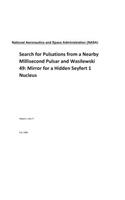
Search for Pulsations from a Nearby Millisecond Pulsar and Wasilewski 49
Series:
Five studies are reported in this final report. The recently discovered 5.3 ms pulsar J1012+5307 at a distance of 520 pc is in an area of the sky which is particularly deficient in absorbing gas. The column density along the line of sight is less than 7.5 x 10(exp 19) CM(exp -2) which facilitates soft X-ray observations. Halpern reported a possible ROSAT Position Sensitive Proportional Counter (PS
49
VOLUME
English
Paperback

Five studies are reported in this final report. The recently discovered 5.3 ms pulsar J1012+5307 at a distance of 520 pc is in an area of the sky which is particularly deficient in absorbing gas. The column density along the line of sight is less than 7.5 x 10(exp 19) CM(exp -2) which facilitates soft X-ray observations. Halpern reported a possible ROSAT Position Sensitive Proportional Counter (PSPC) detection of the pulsar in a serendipitous, off-axis observation. We have now confirmed the X-ray emission of PSR J1012+,5307 in a 23 ksec observation with the ROSAT High Resolution Imager (HRI). A point source is detected within 3" of the radio position. Its count rate of 1.6 +/- 0.3 x 10(exp -3) s(exp -1) corresponds to an unabsorbed 0. 1-2.4 keV flux of 6.4 x 10(exp -14) ergs cm(exp -2) s(exp -1), similar to that reported previously. This counts-to-flux conversion is valid for N(sub H) = 5 x 10(exp 19) cm(exp -2), and either a power-law spectrum of photon index 2.5 or a blackbody of kT = 0.1 keV. The implied X-ray luminosity of 2.0 x 10(exp 30) ergs s(exp -1) is 5 X 10(exp -4) of the pulsar's spin-down power dot-E, and similar to that of the nearest millisecond pulsar J0437-4715, which is nearly a twin of J1012+5307 in P dot-E. We subjected the 37 photons (and 13 background counts) within the source region to a pulsar search, but no evidence for pulsation was found. The pulsar apparently emits over a large fraction of its rotation cycle, and the absence of sharp modulation can be taken as evidence for surface thermal emission, as is favored for PSR J0437-4715, rather than magnetospheric X-ray emission which is apparent in the sharp pulses of the much more energetic millisecond pulsar B1821-24. A further test of this interpretation will be made with a longer ROSAT observation, which will increase the number of photons collected by a factor of 5, and permit a more sensitive examination of the light curve for modulation due to emission from heated polar caps. If fo
Price Comparison [India]
In This Series
Bestseller Manga
Trending NEWS




















